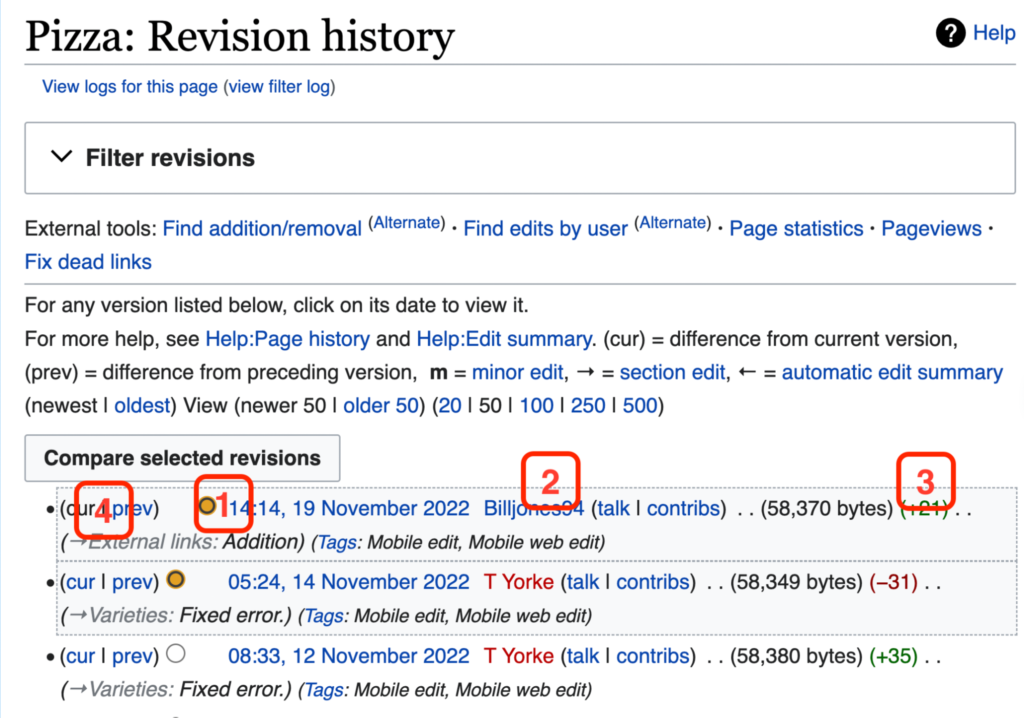Wikipedia is ostensibly a simple platform, a digital utopia where anyone can contribute with only a few clicks and a dream. However, it is deceptively esoteric in its presentation (and application) of its many, many guidelines; thus, managing a Wikipedia page – or even being able to understand what is going on with a Wikipedia page you’re managing – requires an intricate, involved knowledge of how to utilize the many tools and features built into the platform.
It can be overwhelming – but amidst the endless sea of guidelines, policies, rules, templates and tools, peace can be found, with a little bit of knowledge and a few best practices.
Table of Contents

Monitoring your Page
Only one thing is certain on Wikipedia: every page is going to change over time. What those edits are can vary widely, from miniscule maintenance edits to massive content edits.
To see the changes to a page, click on the “View History” tab on the top right corner of any Wikipedia page.

Here is what you’ll see:

1 – When the edit was made (UTC time zone)
2 – Who made the edit (editor username or recorded IP)
3 – How (edit size, description, how performed)
4 – What: clicking the “prev” button will compare it to the preceding version of the page

Crisis Management
So an edit happened…. and it’s not good. Someone added an unsavory historical bit to a Wikipedia page you’re monitoring, or inaccurately interpreted information from a cited news article. Whether vandalistic or well-intentioned, undesired edits to a Wikipedia page are bound to occur over time – in fact, it is quite common, even in the most unexpected places (for example: the Wikipedia page on pizza is protected from public editing, due to various controversies and debates over the years).
So what can you do? Take a hint from Frankie Goes to Hollywood, and RELAX – there are numerous options for trying to intervene on a potentially inaccurate, misleading, or biased edit.

Reversion: if the edit is obviously vandalism or spam, there is a process to manually revert an edit to a page. If a dispute is content-based, however, simple reversion is often a fruitless pursuit, as another editor will restore, if good reason for the reversion is not provided.
Editorial intervention: through the Talk page or other means, trusted editors can get involved and help make decisions about a page’s content or changes.
Let it be – It is important to understand the risks associated with fighting an edit made to a page. The larger or more controversial an edit, the riskier it is to apply any of the aforementioned approaches trying to combat it. Sometimes, it’s best to heed the advice of Paul McCartney and just let it be, especially if it is determined the edit’s impact to the page is minimal; experienced Wikipedia editors tend to be combative, and poking the proverbial bear is a dangerous dance.
Amplify – though a subject’s Talk page is the most effective place to discuss controversial page edits, it is hardly the only place to open discussions. Editor user Talk pages, WikiProject pages, general support pages – there are a myriad of alternative places to post messages or requests, if you are looking to spur dialogue (and potentially activity) around edits to a page.
Seriously – relaX: the most important thing to remember about Wikipedia is that nothing is permanent, and anything is editable. By design, it is a collaborative, incremental platform: changes can take time, and sometimes repeated efforts to garner consensus on an issue. Patience is the most important quality to possess, no matter what strategy you pursue: experienced Wikipedia editors can be particularly headstrong, both as individuals and a collective, and their resilience is not to be underestimated.

When Will This Happen?
In theory, a Wikipedia page can always be edited; however, a large majority of a page’s existence will be idle and uneventful. However, there are three distinct periods where a lot of activity is typically expected and Wikipedia page views tend to spike:
1. Large structural changes: when new sections, images, or large swathes of content are added to a page, numerous experienced editors will notice and review the edit for viability and neutrality. The larger the edit or structural change, the more ancillary activity can be expected in the 30-60 days following the activity.
2. Controversial news: as expected, any significant news from reputable sources will usually lead to an edit to a Wikipedia page, and is usually when public interest in a subject is at its highest – due to how Google utilizes Wikipedia, this can sometimes (but not always) lead to traffic spikes.
What is more important to monitor is controversial news, or anything that involves sensitive topics like legislation or religion: Wikipedia often reflects public sentiment, with the associated kaleidoscope of personal and inherent biases that go along with it, which can lead to protracted debates or ‘edit wars’ when news around sensitive topics or politically relevant subjects occurs.
3. Branding/ownership changes: new images, mission statements, product line changes, or other major shifts in branding can lead to an increased period of Wikipedia activity. Ownership changes also often lead to a spike in Wikipedia views – both from people seeking out more information from the news, and employees looking to learn more about the company they are acquiring (or being acquired by).

Wiki Dos and Dont’s: Employee/Employer Edition
If monitoring a Wikipedia page for a professional reason, there are a few very basic dos and dont’s to remember when getting involved in the Wikipedia project.
DO: Make a professional account that declares a conflict of interest. Company employees who want to edit Wikipedia simply have to pledge to not edit their employer’s page directly – desired edits and requests can be made following any of the steps above, and having an established account known to be connected to the company makes for easier general page management.
DO NOT: edit the page of a company you currently work for. This is explicitly against Wikipedia policy, and will inevitably lead to an undesired result, which can range from page flags to account deletion or page protection.
DO: Get involved! Wikipedia is a place where everyone can find a place to contribute. Just because you work for a company with a Wikipedia page, doesn’t mean you are not allowed to edit and improve other Wikipedia pages – you can make a personal Wikipedia account, and declare the same conflict of interest you would when making a professional account.
DO NOT: Edit/debate with emotion. Wikipedia can be frustrating and even counterproductive at times, and it can be easy to lose hope. Remember – Wikipedia is iterative and collaborative, which often means everybody wants to be involved and nobody will ever be happy. Short-term concessions can lead to long-term results – and though it may be easy to get goaded into name calling or accusations, staying neutral is the most important asset in any Wiki editor’s toolbelt.




